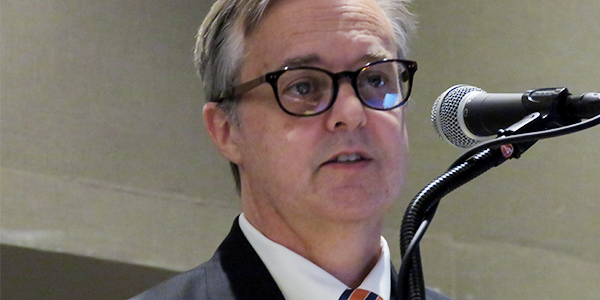By Rich Heidorn Jr.
WASHINGTON — Public Service Electric and Gas has never been a fan of FERC Order 1000. No wonder.
In 2014, PJM staff selected PSE&G to construct a $300 million transmission upgrade for Artificial Island — the RTO’s first competitive project — only to have the RTO’s Board of Managers reopen the bidding following protests from spurned bidders and others. PJM later awarded most of the project to LS Power. (See PJM Board Puts the Brakes on Artificial Island Selection.)
“I’d like to see the whole thing repealed,” Larry Gasteiger, chief of federal regulatory policy for PSE&G’s parent, Public Service Enterprise Group, said during a panel discussion on the landmark order at the Energy Bar Association’s Mid-Year Energy Forum last week.
Gasteiger, a former FERC chief of staff, acknowledged that that outcome is unlikely. He noted that the commission has taken no action to change the rule in the two years since it convened a technical conference to review its performance. (See Five Years Later, FERC Takes Another Look at Order 1000.)
But he said it has not met the commission’s hopes for creating competition. “Outside of the organized markets there has not been any competitive transmission bidding opportunities. Within the organized markets, it’s been mixed … to say the least. SPP’s Walkemeyer project is almost a poster child: spending $5 million on the competitive process for an $8 million project … that got canceled.” (See SPP Cancels First Competitive Tx Project, Citing Falling Demand Projections.)
He said relying on least-cost transmission solutions is akin to buying a $3,990 Yugo, the boxy import car mocked in the 1980s for its low quality.
Justin M. Campbell, chief development officer for GridLiance, a transmission developer backed by the private equity firm Blackstone Group, conceded the order has resulted in cumbersome solicitation processes.
But he said competition is essential to keeping transmission costs — which have risen to 10% of customers’ bills, from 6% in 2006 — under control. He cited LS Power’s winning bid on MISO’s Duff-Coleman project, which came in at $50 million, well below the projected $58.6 million.
He said competition has been hamstrung by state policies driven by incumbent transmission owners and RTOs’ “categorical” exemptions from competition for certain types of projects, such as those for reliability, projects whose costs are allocated locally or solutions below 300 kV.
Campbell rejected Gasteiger’s Yugo comparison, saying the developers competing for projects are not “two-men-and-a-laptop type of outfits.”
“What you’re going to see is Duke [Energy,] Edison [International and] American Electric Power. You’re going to see companies that own tens of thousands of miles of transmission and are fully capable — just like the incumbents,” he said, adding that competitors use many of the same engineering procurement construction (EPC) contractors as incumbents.
“The way we’re able to save cost is in more efficient design. It’s in how we handle the risk allocation between the customer and developer and EPC contractor. So, it’s things like that that [allow savings], not lowballing construction or anything like that.”
He cited a study the Brattle Group did for GridLiance and LS Power that found competitive projects — which often include cost caps or other cost controls — have averaged 40% below initial project cost estimates and could ultimately produce savings of 55%. The report said ratepayers in the U.S. and Canada could save $8 billion over five years if ISOs and RTOs increased the share of transmission investments opened to competition to 33%, up from 2% currently.
Transmission Planning: How Low Can You Go?
Other panelists discussed transmission planning and rates.
Theodore Paradise, ISO-NE’s assistant general counsel for operations and planning, said the rise of behind-the-meter generation and distributed resources may require a rethinking of transmission planning and the distinction between federally regulated transmission and state-regulated distribution. “Maybe it’s time for all of us to figure out where the power system is going as we do system planning looking out 10 years. Do we need to plan down to 115 [kV] for transmission?”
Consultant Paul Dumais, a former Avangrid executive, praised FERC’s Oct. 16 order changing how the commission sets TOs’ return on equity rates, a change expected to increase the ROE cap for Avangrid and other New England Transmission Owners (NETOs). (See FERC Changing ROE Rules; Higher Rates Likely.)
When FERC approved incentive ROE adders for a $1.5 billion Avangrid project about 10 years ago, he said, “it really changed things in the company. There was a focused effort to make sure that capital was appropriated. … And in large part I believe it was due to the fact that there were incentives given for the particular risks and challenges of that project.”
When FERC reduced the NETOs’ ROE cap, however, Avangrid could only collect half of the incentive, Dumais said.
“The Iberdrola folks in Spain [then Avangrid’s parent company] felt they had been bait-and-switched.”
Dumais said he was hopeful that the commission’s new policy will allow it to resolve ROE complaints within the 15- month limit on refunds. Maine regulators, he noted, complete full utility rate cases in 12 months.







